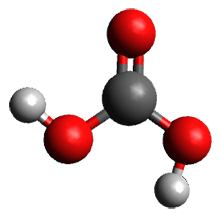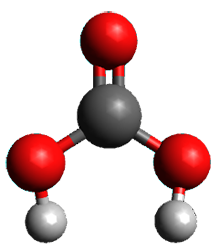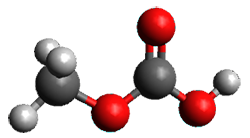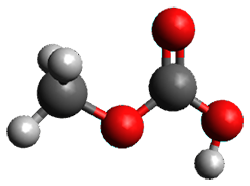I remain amazed at how regularly I read reports of structure determinations of what seem to be simple molecules, yet these structures have eluded determination for decades if not centuries. An example is the recently determined x-ray crystal structure of L-phenylalanine;1 who knew that growing these crystals would be so difficult?
The paper I want to discuss here is on the gas-phase structure of carbonic acid 1.2 Who would have thought that preparing a pure gas-phase sample would be so difficult? Schreiner and co-workers prepared carbonic acid by high-vacuum flash pyrolysis (HVFP) of di-tert-butyl carbonate, as shown in Scheme 1.
Scheme 1

Carbonic acid can appear in three difference conformations, shown in Figure 1. The two lowest energy conformations are separated by a barrier of 9.5 kcal mol-1 (estimated by focal point energy analysis). These conformations can be interconverted using near IR light. The third conformation is energetically inaccessible.
|
1cc |
1ct |
1tt |
|
2cc |
2cc |
|
Figure 1. CCSD(T)/cc-pVQZ optimized structures of 1 (and the focal point relative energies in kcal mol-1) and the CCSD(T)/cc-pVTZ optimized structures of 2.
The structures of these two lowest energy conformations were confirmed by comparing their experimental IR spectra with the computed spectra (CCSD(T)/cc-pVTZ) and their experimental and computed rotational constants.
An interesting added component of this paper is that sublimation of the α- and β-polymorphs of carbonic acid do not produce the same compound. Sublimation of the β-isomorph does produce 1, but sublimation of the α-isomorph produces the methylester of 1, compound 2 (see Figure 1). The structure of 2 is again confirmed by comparison of the experimental and computed IR spectra.
References
(1) Ihlefeldt, F. S.; Pettersen, F. B.; von Bonin, A.; Zawadzka, M.; Görbitz, C. H. "The Polymorphs of L-Phenylalanine," Angew. Chem. Int. Ed. 2014, 53, 13600–13604, DOI: 10.1002/anie.201406886.
(2) Reisenauer, H. P.; Wagner, J. P.; Schreiner, P. R. "Gas-Phase Preparation of Carbonic Acid and Its Monomethyl Ester," Angew. Chem. Int. Ed. 2014, 53, 11766-11771, DOI: 10.1002/anie.201406969.>
InChIs
1: InChI=1S/CH2O3/c2-1(3)4/h(H2,2,3,4)
InChIKey=BVKZGUZCCUSVTD-UHFFFAOYSA-N
2: InChI=1S/C2H4O3/c1-5-2(3)4/h1H3,(H,3,4)
InChIKey=CXHHBNMLPJOKQD-UHFFFAOYSA-N






licexam studymaterial responded on 28 Feb 2016 at 5:01 pm #
Appreciating the time and energy you put into your blog
and iin depth information you provide. It’s awesome tto come across a
blo every once in a while that isn’t the same
unwanted rehashed material. Grreat read! I’ve bookmarked your site
andd I’m adding your RSS feeds to my Googl account.